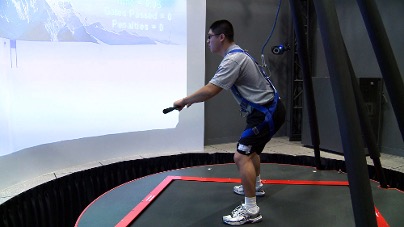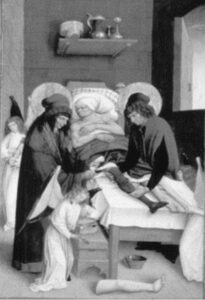
Figure 1: A veteran makes use of the Computer Assisted Rehabilitation Environment at Walter Reed Army Medical Center. The patient stands upon a large, tilting platform and is immersed in a virtual world
Source: Wikimedia Commons
Complete physical and neural rehabilitation after a devastating injury or disease is an extremely difficult process. Intense treatment and work is required to prevent muscular atrophy and encourage repair of neurological pathways involved in restoring normal movement. The most prevalent cause of this type of disability is stroke, where brain cells die because blood flow is obstructed in some way. Strokes regularly leave patients with both motor and neurological deficits. Although improved medical technology has allowed an increased proportion of stroke victims to survive long-term, many patients are still left with severe disabilities (Brandão et al., 2020). Due to an increase in the population of patients with physical and neurological injury, many companies are searching for new treatments that would aid their rehabilitation.
One very promising treatment is the use of virtual reality (VR) systems to help patients regain mobility. VR stimulates the senses of the user, specifically affecting their sight and hearing and retraining their brain to receive and process sensory information. By stimulating specific neural connections, the brain is triggered to repair targeted pathways (FAPESP, 2020). For example, patients with limited range of motion are put into a VR environment that senses their reduced movements. Their avatar in the VR environment responds by performing the full movement, giving the user the illusion of overcoming their injury, and regaining full motion. This therapy potentially activates neural pathways that were previously unused or damaged by simulating a healthy body’s ability (FAPESP, 2020). Studies have shown this treatment method to be effective, as patients using VR (in addition to regular physical therapy) heal at a higher rate (Aşkın et al., 2018). With this demonstrated success, many companies and research groups are looking to develop technology that refines and improves the use of VR for physical therapy.
One such group of researchers has developed a biomechanics sensor node (BSN) that lends itself very well to these applications. The developed BSN recognizes movement in all three planes and is coded to detect motion using stationary gait, motion patterns generated by someone walking in place (FAPESP, 2020). Three-dimensional spatial recognition allows for much more finely- tuned VR tracking, especially as compared to one dimensional sensors, a common type on the current market. The BSN also controls the VR environment and tracks patient movement, allowing doctors to detect small deviations of stationary gait (FAPESP, 2020). This new BSN would be extremely useful in conjunction with existing VR technology as it can provide more targeted care.
Overall, the practice of using VR as a rehabilitation technology is rapidly developing, and new inventions such as the BSN are pushing further the current boundaries of the field. As these technologies develop, they have great potential to improve physical therapy for many patients.
References
FAPESP. (2020, December 15). Virtual reality applied to rehabilitation for stroke and neurodegenerative disease patients. Retrieved December 22, 2020, from https://medicalxpress.com/news/2020-12-virtual-reality-neurodegenerative-disease-patients.html
Alexandre Fonseca Brandão et al (2020). Biomechanics Sensor Node for Virtual Reality: A Wearable Device Applied to Gait Recovery for Neurofunctional Rehabilitation, Computational Science and Its Applications – ICCSA 2020. DOI: 10.1007/978-3-030-58820-5_54
Aşkın, A., Atar, E., Koçyiğit, H., & Tosun, A. (2018). Effects of Kinect-based virtual reality game training on upper extremity motor recovery in chronic stroke. Somatosensory & motor research, 35(1), 25–32. https://doi.org/10.1080/08990220.2018.1444599
Related Posts
Overview, History, Essential Concepts, and Current Topics in Transplant Immunology
First Author: Anahita Kodali1 Co-Authors: Vaishavi Agrawal2, Vivek Babu3, Sakeena...
Read MoreThe Biochemistry and Broad Utility of Pfizer’s New COVID-19 Drug: Paxlovid
A photo of a Pfizer facility in Italy. (Image Source:...
Read MoreLooking into the Past for a Glimpse of the Future: Using Medieval Tonics as Modern Antibiotics
Figure 1: In the image above, one can see a...
Read MoreCallie Moody




Comments are closed.